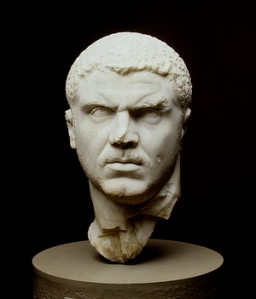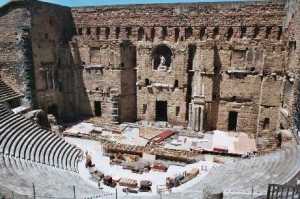For my Art History students, here are the pieces that will be on your test and just a few notes to jog your memory. Hopefully you will know more details. As a note, I’ve tried to use pics that are public domain, but it is sometimes hard to determine and/or get permission. I’d sure like input from anyone on how people handle using images on the Internet of things like art pieces…it seems everyone has the same ones…..Are there guidelines somewhere?
In no particular order on this post here are the pieces you will need to be familiar with.

Bronze of Romulus and Remus and the she-wolf. Etruscan
A Bronze piece from the Etruscans. Legend has it that Rome was founded by twin boys Romulus and Remus. The details vary but the basic story is that the boys father was king, their uncle overthrew him, and then ordered the boys to be killed. They were abandoned by the river, adopted by a wolf who raised them as her cubs. They were then discovered by a shepherd who had no children of his own and so he and his wife raised the boys. They learned of their royal birth, attacked their uncle, restored their father to his kingdom, and then set out to make their own kingdoms. The twins settled in on the Palatine Hills and here there are several stories, but basically, as with their father and uncle before them, they were not capable of sharing and so contest and battles ensue leaving Romulus the victor and Remus dead. Romulus then goes on to found the city of Rome.

An Etruscan town
This is an example of Etruscan architecture. By taking note of the car in the bottom of the picture you can see the size and grandeur of the cities built by the Etruscan’s. Also you are given an example of an arch. The arch will become a trademark of Roman architecture. This wall that surrounds the city provided security and also told visitors of the might of the people who dwelt there.

Model of an Etruscan temple
This model of an Etruscan temple shows an interesting mix of influences that the Romans would adapt and change to suit their own building projects. The porch area resembles the ancient Greek temples that we have studied, although here the front steps are a small set of steps on the front of the temple as opposed the Greek style of stairs surrounding the entire porch or temple. As with other ancient buildings the Etruscans painted their temples with bright colors. Statuary was put on the roof and around the temple. This temple has three cella’s, or areas that would have had a votive statue to a god or goddess within them. Note that this part of the temple is closed, not open to someone just walking by.

Etruscan, terra-cota sarcaphogas.
This sarcophagus was made for an Etruscan. Terra-cotta was a challenging medium to work in and demanded that it’s artist have precise control over the temperature and time as they fired items. We can see in this piece a family enjoying an intimate moment. There is none of the formality or obsession with the dead in this as we have observed in the Egyptians. With the Greeks we often saw expressions of grief and loss…while in this piece we seem to have a fond remembrance of the deceased. We are meant to celebrate their life.

Aullus Metellus, The Orator
This bronze of Aulus Metellus is life-sized. We know his name because it is inscribed on the hem of his clothing. The statue has been known since ancient times as ‘The Orator’ and the man stands as if addressing a crowd. He wears sturdy leather boots, an interesting thing to note…gods and goddesses were depicted barefoot and later on we will see that Augustus was sculpted barefoot, perhaps hinting at his deification.
Note the differences between this statue and similar Greek statues. While both cultures made statues of their leaders to instill confidence there are marked differences. Most notable at first glance, our Roman is clothed. Secondly, he wears shoes, going barefoot was a sign that the statue was of a god. Also, our orator appears to have been a real person. The Romans generally presented their leaders with recognizable features as they appeared in life. The Greeks presented idealized statues of their leaders showing them as gods with perfect proportions, bodies, and strength.
This piece was done during the Republican period of Rome when leaders in the Senate ruled (ideally) through reason and with the support of the people. The Senate was the governing body and the ability to speak eloquently was paramount to success.

Caesar Augustus, Augustus Caesar, Octavian
In contrast this bronze of Caesar Augustus was done at the beginning of the Imperial period of Romes History. Augustus would become the first emperor of Rome and would make use of sculpture as a form of propaganda. In this work Augustus is presented in the same pose as the orator, illustrating that he is a civilized ruler who rules with reason and the support of the senate. But there are also marked differences between this work and the one above.
We see a more idealized portrayal of Augustus here, he is presented in his youth as the height of his strength with a calm, sure expression. He is wearing his armor to show his skills as a general. His feet are barefoot, a nod to his deification in later life. At his feet rides cupid on a dolphin. This is meant to remind the viewer that Augustus claimed to be descended from Venus. (Remember, Cupid is Venus’s son.)
This work was placed in the entry way of Livia’s villa. Livia was Augustus’s wife and this statue would have greeted guests as they entered the villa.

Bust of Caraculla
Contrast the previous two works with this bust of the emperor Caracalla. As Augustus had before him, Caracalla is seeking to send a message to his people as to what kind of a man he is.
Here we see a man who will be ruling with an iron fist. He is hard, cold, and will do what needs doing. He ruled during a time of anarchy and unrest with a constant turnover in leaders. He had to be constantly vigilant against would be usurpers to his power. All of this is reflected in his face. This is not a man who is going to tolerate any dissension in the ranks.
Due to the length of this post I’m going to have to do it in parts. Part two should post shortly.

 head, arms, and legs out of marble and then used bronze for the drapery of the fabric. All that remains of the statue is the marble pieces. This statue was supposedly used as a stand-in for the emperor whenever the conduct of business legally required his presence. The sculpture combines traditional Roman practices of portraying people as they truly looked, with his heavy jaw, hooked nose, and jutting chin….with a rigid symmetrical simplicity that illicits power and imperial dignity. There is no hint of frailty or imperfection in the sculpture.
head, arms, and legs out of marble and then used bronze for the drapery of the fabric. All that remains of the statue is the marble pieces. This statue was supposedly used as a stand-in for the emperor whenever the conduct of business legally required his presence. The sculpture combines traditional Roman practices of portraying people as they truly looked, with his heavy jaw, hooked nose, and jutting chin….with a rigid symmetrical simplicity that illicits power and imperial dignity. There is no hint of frailty or imperfection in the sculpture.













